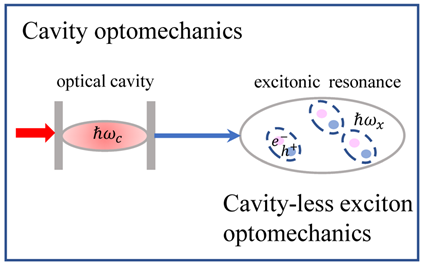Researcher Zhang Jun's team from State Key Laboratory for Superlattices and Microstructures, Institute of Semiconductors, Chinese Academy of Sciences has made new progress in optomechanical coupling research and was invited by Nanoscale magazine to publish an original article "Terahertz cavity optomechanics using a topological nanophononic superlattice" and a review article "From cavity optomechanics to cavity-less exciton optomechanics: a review" in its "Nanoscale Quantum Technologies" themed collections.

Fig.1 Terahertz optomechanical device based on nanophononic superlattice
Cavity optomechanical systems operating at the quantum ground state provide a novel way for the ultrasensitive measurement of mass and displacement and provide a new toolbox for emerging quantum information technologies. The high-frequency optomechanical devices could reach the quantum ground state at a high temperature because the access to high frequency is favorable for the cavity optomechanical devices to decouple from the thermal environment. However, reaching ultra-high frequency (THz) is extremely difficult due to the structure of cavity optomechanical devices and properties of materials. In this work, Jun Zhang’s team introduced nanophononic topological interface state into the optomechanical system, and used the finite element calculation method to design a cavity optomechanical device with terahertz mechanical frequency based on GaAs/AlAs nanophononic semiconductor superlattice. In this optomechanical system, by increasing the length of the optical resonant cavity, multiple optical cavity modes can be obtained, and the frequencies between adjacent optical modes are not equal; changing the thickness of GaAs layer and the AlAs layer in the nanophononic superlattice can make the frequency difference between an adjacent optical mode equal to the frequency of the mechanical mode (i.e., optomechanical frequency matching). By detuning the laser pump to a lower (higher) energy-resolved sideband, the spontaneously scattered photons can be made to achieve double resonance at the anti-Stokes (Stokes) frequency and the pump frequency, which offers the potentials to realize laser cooling as well as low-threshold phonon lasing in this optomechanical system. At the same time, the optomechanical device can be grown by mature molecular beam epitaxy (MBE) technology, laying a foundation for the application of ultra-high frequency optomechanical devices. On August 17, 2022, the research results were published online in Nanoscale, (2022), 14, 13046-13052, titled "Terahertz cavity optomechanics using a topological nanophononic superlattice". Researcher Zhang Jun is the corresponding author, and master student Chang Haonan is the first author. The collaborators include Dr. Yao Qifeng from Beijing Institute of Quantum Information, Dr. Liu Bin from Nanjing Guoke Semiconductor Corporation, researcher Lou Wenkai from the Institute of Semiconductors, Chinese Academy of Sciences, researcher Ni Haiqiao, researcher Niu Zhichuan, and academician Chang Kai.

Figure 2 In a cavity-less exciton optomechanical system, the optical resonance in the optical cavity is replaced by the excitonic resonance
Zhang Jun and his colleagues achieved the resolved sideband Raman cooling and heating longitudinal optical (LO) phonon in a semiconductor ZnTe nanoribbon using the Fr?hlich force generated by light on longitudinal optical (LO) phonons under the strong coupling of phonon-excitons to in 2016, demonstrating that the optical manipulation of single optical phonon states in semiconductors is fully achievable under strong exciton-phonon coupling (Nature Photonics 10, 600–605 (2016)); In 2022, Zhang Jun’s team achieved laser cooling of single optical phonons in two-dimensional van der Waals crystals (Nano Lett. 22, 7129–7135 (2022)). Recently, Zhang Jun's team wrote a review paper on the cavity-less exciton optomechanical coupling. This review systematically describes the development trend of optomechanical devices from "cavity" to "cavity-less", which is of great reference value for scientific researchers and technicians engaged in the research and application of optomechanics. On September 23, 2022, this review was published online in Nanoscale (2022) DOI: 10.1039/D2NR03784J with the title "From cavity optomechanics to cavity-less exciton optomechanics: a review". Researcher Zhang Jun is the corresponding author, and master student Chang Haonan is the first author.
The above research work has been supported by the National Key R&D Program, the National Natural Science Foundation of China, the Innovation Intersection Team of the Chinese Academy of Sciences and the Strategic Pilot Project of the Chinese Academy of Sciences.
Link to the paper
[1] H. N. Chang, Z. Y. Li, W. K. Lou, Q. F. Yao, J. M. Lai, B. Liu, H. Q. Ni, Z. C. Niu, K. Chang, and Jun Zhang, Terahertz cavity optomechanics using a topological nanophononic superlattice, Nanoscale (2022), DOI:10.1039/D2NR03376C.
[2] H. N. Chang, and J. Zhang, From cavity optomechanics to cavity-less exciton optomechanics: a review, Nanoscale (2022), DOI:10.1039/D2NR03784J.